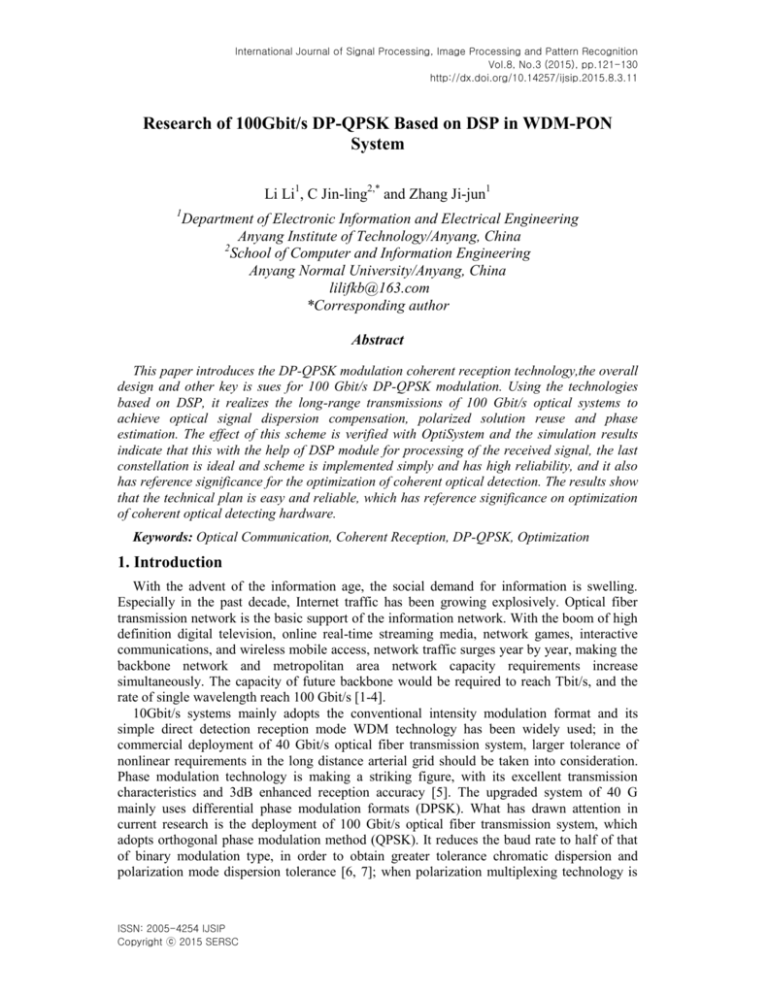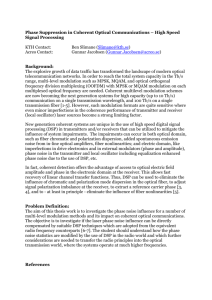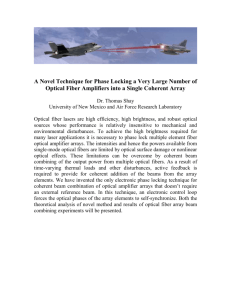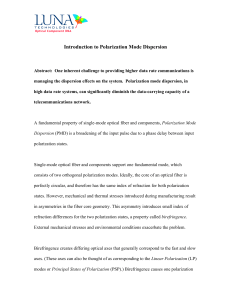Research of 100Gbit/s DP-QPSK Based on DSP in WDM
advertisement

International Journal of Signal Processing, Image Processing and Pattern Recognition Vol.8, No.3 (2015), pp.121-130 http://dx.doi.org/10.14257/ijsip.2015.8.3.11 Research of 100Gbit/s DP-QPSK Based on DSP in WDM-PON System Li Li1, C Jin-ling2,* and Zhang Ji-jun1 1 Department of Electronic Information and Electrical Engineering Anyang Institute of Technology/Anyang, China 2 School of Computer and Information Engineering Anyang Normal University/Anyang, China lilifkb@163.com *Corresponding author Abstract This paper introduces the DP-QPSK modulation coherent reception technology,the overall design and other key is sues for 100 Gbit/s DP-QPSK modulation. Using the technologies based on DSP, it realizes the long-range transmissions of 100 Gbit/s optical systems to achieve optical signal dispersion compensation, polarized solution reuse and phase estimation. The effect of this scheme is verified with OptiSystem and the simulation results indicate that this with the help of DSP module for processing of the received signal, the last constellation is ideal and scheme is implemented simply and has high reliability, and it also has reference significance for the optimization of coherent optical detection. The results show that the technical plan is easy and reliable, which has reference significance on optimization of coherent optical detecting hardware. Keywords: Optical Communication, Coherent Reception, DP-QPSK, Optimization 1. Introduction With the advent of the information age, the social demand for information is swelling. Especially in the past decade, Internet traffic has been growing explosively. Optical fiber transmission network is the basic support of the information network. With the boom of high definition digital television, online real-time streaming media, network games, interactive communications, and wireless mobile access, network traffic surges year by year, making the backbone network and metropolitan area network capacity requirements increase simultaneously. The capacity of future backbone would be required to reach Tbit/s, and the rate of single wavelength reach 100 Gbit/s [1-4]. 10Gbit/s systems mainly adopts the conventional intensity modulation format and its simple direct detection reception mode WDM technology has been widely used; in the commercial deployment of 40 Gbit/s optical fiber transmission system, larger tolerance of nonlinear requirements in the long distance arterial grid should be taken into consideration. Phase modulation technology is making a striking figure, with its excellent transmission characteristics and 3dB enhanced reception accuracy [5]. The upgraded system of 40 G mainly uses differential phase modulation formats (DPSK). What has drawn attention in current research is the deployment of 100 Gbit/s optical fiber transmission system, which adopts orthogonal phase modulation method (QPSK). It reduces the baud rate to half of that of binary modulation type, in order to obtain greater tolerance chromatic dispersion and polarization mode dispersion tolerance [6, 7]; when polarization multiplexing technology is ISSN: 2005-4254 IJSIP Copyright ⓒ 2015 SERSC International Journal of Signal Processing, Image Processing and Pattern Recognition Vol.8, No.3 (2015) used, the capacity of single carrier signal can be doubled, and then the polarization diversity optical coherent detection technology can be applied [8]. Dual-Polarization Quadrature Phase Shift Keying (DP-QPSK) transmission system based on the technology of coherent reception has become the mainstream scheme of 100 Gbit/s transmissions, especially in the recent OFC meeting and OECC international conference, scholars from different countries reported a large number of theoretical and empirical works on DP-QPSK. With the increasingly system velocity rate of transmission, the optical fiber dispersion (CD) and the polarization mode dispersion (PMD) will result in heavier damage to the optical signals carried. So there is need for effective monitoring and compensation for optical signal property [9]. Now in terms of compensation of long-distance optical fiber transmission loss, the research is most based on the digital signal processing (DSP) linear damage compensation technology [10-11]. Such as the estimation and compensation of CD and PMD using DSP in electrical field, reference [12] Fabian N. Hauske from HUAWEI. In reference [13] 40 Gbit/s QPSK signal polarization multiplexing transmission was used in single-mode fiber (SMF) for 100 km, signals received are processed via A/D conversion offline DSP. In 2008, the Nortel research team reported a coherent optical communication experiment, which is a milestone. They used CMOSASIC chip combined with DSP technology to realize the 40 Gbit/s DP-QPSK (10 Gsymbol/s) optical fiber transmission of real-time coherent detection system demonstration [14-15], which verified the practical value of coherent detection in the future high-speed optical fiber communication system. This paper will explore this issue based on the joint simulation of OptiSystem, employ DSP technology in electric field at the end of optical reception machine, to achieve the dispersion compensation of polarization multiplexing and methods such as polarization dispersion compensation solutions for reuse and phase estimation by means of sampling software optimization and signal recovery. Then we analyzed the compensation effect of the system, and provided reference for hardware optimization design. 2. DP-QPSK Demodulation Principle 2.1. DP-QPSK Signal Modulation This modulation format used polarization multiplexing, carrying on each polarization phase an independent QPSK signal. Shown in Figure 1 is the production structure of DP-QPSK signal structure. It will first deal with electrical signals in the electrical field. If the input data is only one road, we should separate the data first and then get four roads of electrical signals, then perform difference pre-coding. As shown in Figure 1, if there are four road input signal, we can make difference pre-coding directly. If the input is continuous light, it will be separate by PBS (Polarization Beam Splitter) into two beams, which are orthogonal polarized with equal power. The two orthogonal polarization lights are input to an IQ modulator to be modulated and then we get two QPSK signal path. In the end, the two orthogonal polarized QPSK signal get through a Polarization Beam splitter PBC (Polarization Beam Combiner) synthesize into one beam of light to get a DP-QPSK signal. 122 Copyright ⓒ 2015 SERSC International Journal of Signal Processing, Image Processing and Pattern Recognition Vol.8, No.3 (2015) XI IQ Modulator 1 MZM MZM Precoder Data Input 1:4 Optical Splitter XQ PM Ein PBC PBC Eout MZM YI MZM YQ PM IQ Modulator 2 Figure 1. DP-QPSK Modulation Principle Diagram The continuous light input is described by formula (1). P0 stands for input light intensity and w0 stands for angular frequency of the input light: Ein p0 e jw0t (1) The Input light went through PBS to get EA and Ea, the two orthogonal and equally powered polarized light: 2 p0 jwt e ex 2 2 p0 jwt Ea e ey 2 EA (2) (3) The two beam of polarized light are then input into the IQ modulator to get two orthogonal QPSK signal. IQ modulator is actually made of two MZM, one PM, and two 3 db of the directional coupler. Quaternary phase shift keying (QPSK) is a four-element digital frequency modulation mode. Its sine signal carrier has four possible state of discrete phase and phase state is usually [π/4, 3π/4, 5π/4, 7π/4], each carrier phase caring two binary notation. 2.2. DP-QPSK Signal Demodulation Coherent detection technique is used in demodulating DP-QPSK optical signal. The Local Oscillator laser (Local Oscillator) signal light after the equal splitting will be two 90° mixer coherent light source. The signal light get through the polarization beam splitter (PBS) and is separated into two mutually orthogonal polarization roads of optical signals, and then enter into two 90° mixer to interfere with the light of vibration signal respectively. The light produced by balance mixer can be converted into analog signals after balance reception of photodiode. The signals then get through a high-speed ADC sampling quantization to be converted into digital signals, and realize data recovery in the digital signal processor. The principle of coherent reception figure is shown in Figure 2. Copyright ⓒ 2015 SERSC 123 International Journal of Signal Processing, Image Processing and Pattern Recognition Vol.8, No.3 (2015) 90° Optical Mixer Signal Beam Es ADC 90° Optical Mixer Local Beam Elo IX ADC QX IY ADC ADC QY Figure 2.The Principle Diagram of DP-QPSK Coherent Reception 3. DP-QPSK System Recovery Algorithm 3.1. DP-QPSK Signal Coherent Detection Polarization diversity technology is separating the signal light and the local oscillator into two orthogonal polarization phase, and get light of the same polarization phase to be received through phase diversity receiver, then collect the two orthogonal polarization information and finally isolated by DSP to get two orthogonal polarization information. Signals will get two orthogonal beam of polarized light EDP-QPSK-X, EDP-QPSK-Y at the front tip of the coherent optical receiver PBS, then the two polarized light beam respectively use two 90 ° mixer for optical coherent reception. For easier analysis, this article will simplify EDP- QPSK-X, EDP-QPSK-Y to: EDPQPSK , X Ax (t ) exp( j 2f 0t ) exp[ j r , x (t )] (4) EDPQPSK ,Y Ay (t ) exp( j 2f 0t ) exp[ j r , y (t )] (5) Ax(t), Ay(t) is the electric field amplitude to receive light signals X,Y, and fo is the laser frequency of transmitter. The θrx, theθry for X and Y are signal phases on the polarization (including phase modulation and phase damage in transmission). 90° mixer output 4 road light signal of the electric field components ideally, which are: 2 ELO EDP QPSK , X 2 2 E 2 DP QPSK , X 2 ELO 2 j 2 EDP QPSK , X ELO 2 j 2 ELO EDP QPSK , X 2 (6) Then we will perform balance light detection on 4 roads of signals from the 90° mixer. Thus getting the same phase and the orthogonal component of the light detection electric current. 124 X I R 2PLO As (t ) cos[2 ( f 0 f LO )t r , x (t ) LO (t )] (7) X Q R 2PLO As (t ) sin[2 ( f 0 f LO )t r , x (t ) LO (t )] (8) Copyright ⓒ 2015 SERSC International Journal of Signal Processing, Image Processing and Pattern Recognition Vol.8, No.3 (2015) Among them, R is the response of the photodiode. Through the coherent detection, the amplitude and phase information from the signal light field can be reserved into the converted electric signal. Current signal will be managed through the filter and trans-resistance amplifiers, and enter into a back-end processing chip DSP. The electric signal after being tackled, it can demodulate the original information. 4. DP-QPSK Transmission System Simulation and Analysis 4.1. Coherence Reception Data Recovery Numerical Analysis Numerical simulation is produced using optisystem software modulation signal, and detected through the coherent receiver. Sampling data will be processed in Matlab. We set simulation signal modulation format DP-QPSK which its baud rate to be 25 Gbaud, 50 Gs/s for sampling rate, 29-1 for PRBS cycle length, 65536 for the length of the test data. Signal data recovery is mainly involved in three steps which are as follows: Dispersion compensation, Polarized solution reuse and carrier recovery. The signal recovery process is shown in Figure 3, the sampling data should first get through FIR static filter to realize dispersion compensation, and the tap coefficient is determined by the amount of optical fiber dispersion, then we resample the signal. After that, the data will get trough four FIR butterfly filter to realize Polarized solution reuse. The next step is to use the CMA algorithm that is self-adaption to update FIR tap coefficient, and choose FFT frequency domain search algorithm to estimate the frequency difference between the signal and the local oscillator. Continuously, we use the Viterbi-Viterbi algorithm to estimate and recover two polarization signals’ Carrier phase respectively. Finally, we judge signals and calculate bit error rate. CMA IX FIR Filter Resampl e QX hXY FFTFrequency Offset Estimation hYX QY IY εX hXX FIR Filter Resampl e Viterbi-Viterbi BER Estimation Viterbi-Viterbi εY hYY CMA Figure 3. The Principle Diagram of Coherence Reception Data Recovery 4.2. Analysis of Dispersion Compensation In this article we choose time domain compensation algorithm. The coefficient of the optical fiber dispersion coefficient is 17 ps/nm/km. When the signal transmits 1000 km, the signal to noise ratio is 15dB regardless of the fiber nonlinearity and PMD effect. Figure 4 shows the relationship between FIR filter tap number and Signal bit error rate. Because FIR filter is limited shock response of truncation time domain, it will cause spectrum overlapping effect if the tap number is too small. When the tap number is less than 250, signal error rate will rise quickly. After 1000 km optical fiber dispersion, the tap number of FIR filter should be no more than 250, thus ensuring ideal dispersion compensation. Copyright ⓒ 2015 SERSC 125 International Journal of Signal Processing, Image Processing and Pattern Recognition Vol.8, No.3 (2015) 10 -2 10 10 -3 10 10 150 200 250 300 350 400 Figure 4. The Diagram of FIR Filter Tap Number and BER 9 taps 13taps -2 -3 -4 0 20 40 60 80 100 120 140 Figure 5. The Diagram of Group Delay and BER Figure 5 shows the relationship between group delay and bit error rate. When the tap number of FIR filter is 13, this algorithm can tolerate 100 ps group delay. However, if the group delay is more than 100 ps, the signal error rate rise fast; first-order PMD tolerance is associated with FIR tap number. When tap number decreases, group delay tolerance declines. 4.3. Analysis of System Simulation Test Results The 100 Gbps DP-QPSK systems can be divided into five main parts: DP-QPSK Transmitter, Transmission Link, Coherent Receiver, Digital Signal Processing, and Detection & Decoding (which is followed by direct-error-counting). The signal is generated by an optical DP-QPSK Transmitter, and is then propagated through the fiber loop where dispersion and polarization effects occur. It then passes through the Coherent Receiver and into the DSP for distortion compensation. The fiber dispersion is compensated using a simple transversal digital filter, and the adaptive polarization demultiplexing is realized by applying the constant-modulus algorithm (CMA). A modified Viterbi-Viterbi phase estimation algorithm (working jointly on both polarizations) is then used to compensate for phase and frequency mismatch between the transmitter and local oscillator (LO). After the digital signal processing is complete, the signal is sent to the detector and decoder, and then to the BER Test Set for direct-error-counting. Constellation diagrams are shown in Figure 6. You can see from Figure 6(a), both in signal phase distribution and amplitude, the distribution is more decentralized. The dispersion is strong, and there may be a phase noise. Therefore, we can not directly extract raw data; as you can see in Figure 6(b), we set the residual dispersion to 217.75 ps/nm; after dispersion compensation, the sampling point in the constellation diagram becomes an uneven distribution of circular ring, and the density of sampling points is large because of the difference of the sampling point phase of each point. The sampling point is on a circle whose radius is the distance of the origin to their own circle, and it rolls along anti-clockwise or clockwise direction (the direction is determined by the phase difference of the symbol). As can be seen from Figure 6(c), the overall distribution is more concentrated, but at the moment, the phase noise is still heavy, which will cause the point distribution rolling around the center in the constellation diagram. In Figure 6(d), the distribution of each point is more concentrated and is far from the boundary, and noise has decline to a reasonable level. This suggests that, the signal disposed by DSP,decoding and deserializing ,has a bit error rate less 126 Copyright ⓒ 2015 SERSC International Journal of Signal Processing, Image Processing and Pattern Recognition Vol.8, No.3 (2015) than 1.3 e-4 , which is already close to zero. By testing the eye chart, both original signal and demodulation signal has a high quality. Eyes are clean, and open degree is high. polarization X polarization Y (a) Electrical constellation and eye diagram before DSP polarization X polarization Y (b) Electrical constellation after dispersion compensation polarization X polarization Y (c) Electrical constellation after polarization multiplexing Copyright ⓒ 2015 SERSC 127 International Journal of Signal Processing, Image Processing and Pattern Recognition Vol.8, No.3 (2015) polarization X polarization Y (d) Electrical constellation after carrier phase estimation Figure 6. Electrical Constellation Diagrams and Test Eye Diagram 5. Concluding Remarks Optical coherent detection electrical domain equalization is the mos t prospect technology in practical application among high-speed long-distance optical fiber transmission technologies. In this paper, we achieved an ideal result by constructing coherent detection optical transmission system, using DSP module to process re ceived signal. The constellation diagram is distinguishable and the data transmission error rate is around zero. The results show that the technical plan is easy and reliable, which has reference significance on optimization of coherent optical detecting hardware. Acknowledgements This work was supported by the tackle key problems in science and technology of Henan Provincial (122102210017) and education department of Henan province science and technology research projects (13B510008) and foundation and advanced research projects of Henan province (122300410353). References [1] A. H. Gnauck, R. W. Tkach, A. R. Chraplyvy and T. Li, “High-capacity optical transmission systems [J]”, Journal of Lightwave Technology, vol. 26, no. 9, (2008), pp. 1032-1045, DOI: 10.1109/JLT.2008.922140 [2] H. Wernz, S. Bayer and B E. Olsson, “112Gb/s PolMux RZ-DQPSK with fast polarization tracking based on interference control [C]”, Optical Fiber Communication Conference, Optical Society of America, (2009): OTuN4. http://dx.doi.org/10.1364/OFC.2009.OTuN4 [3] G A. Mahdiraji, M K. Abdullah and M. Mokhtar, “70-Gb/s amplitude-shift-keyed system with 10-GHz clock recovery circuit using duty cycle division multiplexing [J]”, Photonic Network Communications, vol. 19, no. 3, (2010), pp. 233-239, DOI:10.1007/s11107-009-0228-4 [4] X. Zhou, J. Yu and D. Qian, “8x114 Gb/s, 25-GHz-spaced, PolMux-RZ-8PSK transmission over 640 km of SSMF employing digital coherent detection and EDFA-only amplification[C]Optical Fiber Communication Conference”, Optical Society of America, 2008: PDP1. DOI: 10.1109/JLT.2008.2008661 [5] A. Sheetal, A K. Sharma and R S. Kaler, “Simulation of high capacity 40Gb/s long haul DWDM system using different modulation formats and dispersion compensation schemes in the presence of Kerr's effect [J]”, Optik-International Journal for Light and Electron Optics, vol. 121, no. 8, (2010), pp. 739-749, DOI: 10.1016/j.ijleo.2008.11.009 [6] J. Yu, X. Zhou and L. Xu, “A novel scheme to generate 100Gbit/s DQPSK signal with large PMD tolerance [C]”, National Fiber Optic Engineers Conference, OSA Technical Digest Series (CD)(Optical Society of America, 2007), paper JThA42. 2007. DOI: 10.1109/OFC.2007.4348335 128 Copyright ⓒ 2015 SERSC International Journal of Signal Processing, Image Processing and Pattern Recognition Vol.8, No.3 (2015) [7] D. van den Borne, S L Jansen and E Gottwald, “DQPSK modulation for robust optical transmission[C]”, Optical Fiber Communication Conference. Optical Society of America, 2008: OMQ1. DOI: 10.1109/OFC.2008.4528385 [8] A Leven, N Kaneda and U V Koch, “Coherent receivers for practical optical communication systems[C]”, Optical Fiber Communication Conference. Optical Society of America, 2007: OThK4. DOI: 10.1109/OFC.2007.4348697 [9] G Charlet, J Renaudier and P Brindel, “Performance comparison of DPSK, P-DPSK, RZ-DQPSK and coherent PDM-QPSK at 40Gb/s over a terrestrial link[C]”, Optical Fiber Communication Conference. Optical Society of America, 2009: JWA40. http://dx.doi.org/10.1364/NFOEC.2009.JWA40 [10] J Sakaguchi, B J Puttnam and W Klaus, “19-core fiber transmission of 19x100x172-Gb/s SDM-WDM-PDMQPSK signals at 305Tb/s[C]”, National Fiber Optic Engineers Conference. Optical Society of America, 2012: PDP5C. 1. [11] S J. Savory, “Digital filters for coherent optical receivers [J]”, Optics Express, vol. 16, no. 2, (2008), pp. 804817, http://dx.doi.org/10.1364/OE.16.000804 [12] M. Birk, P. Gerard and R Curto, “Field trial of a real-time, single wavelength, coherent 100 Gbit/s PM-QPSK channel upgrade of an installed 1800km link [C]”, National Fiber Optic Engineers Conference. Optical Society of America, 2010: PDPD1. http://dx.doi.org/10.1364/NFOEC.2010.PDPD1 [13] J Zhang, J Yu and N Chi, “Multi-Modulus Blind Equalizations for Coherent Quadrature Duobinary Spectrum Shaped PM-QPSK Digital Signal Processing [J]”, Journal of Lightwave Technology, vol. 31, no. 7, (2013), pp. 1073-1078, DOI: 10.1109/JLT.2013.2242429 [14] J Yu, Z Dong and H C Chien, “Transmission of 200 G PDM-CSRZ-QPSK and PDM-16 QAM with a SE of 4 b/s/Hz [J]”, Lightwave Technology, Journal of, vol. 31, no. 4, (2013), pp. 515-522, DOI: 10.1109/JLT.2012.2212420 [15] H. Sun, K T Wu and K. Roberts, “Real-time measurements of a 40 Gb/s coherent system [J]”, Optics Express, vol. 16, no. 2, (2008), pp. 873-879, DOI: 10.1364/OE.16.000873 Authors L. Li, he received his B.Sc. degree in 2007 and received his M.Sc. degree from East China Jiaotong University, Nanchang, China, in 2010.He joined the Anyang Institute of Technology in 2010 as a lecturer in the Departments of Electronic Information and Electrical Engineering. He has published some papers in the journals and conference proceedings which ware indexed by SCI&EI. His major research interests are in optical communication, WDM-PON, QoS guarantees and security. C. Jin-ling, she received her M.Sc. degree from Henan Normal University, Xinxiang, China in 2007. She joined the Anyang Normal University in 2012 as professor. Her current areas of research interests include Communication and Computer application technology. Z. Ji-jun, she received her B.Sc. degree from Nanjing University of Aeronautics and Astronautics, Nanjing, China in 1983. Presently she is working as a Dean of Departments of Electronic Information and Electrical Engineering. Her current areas of research interests include Communication and Qos. Copyright ⓒ 2015 SERSC 129 International Journal of Signal Processing, Image Processing and Pattern Recognition Vol.8, No.3 (2015) 130 Copyright ⓒ 2015 SERSC








